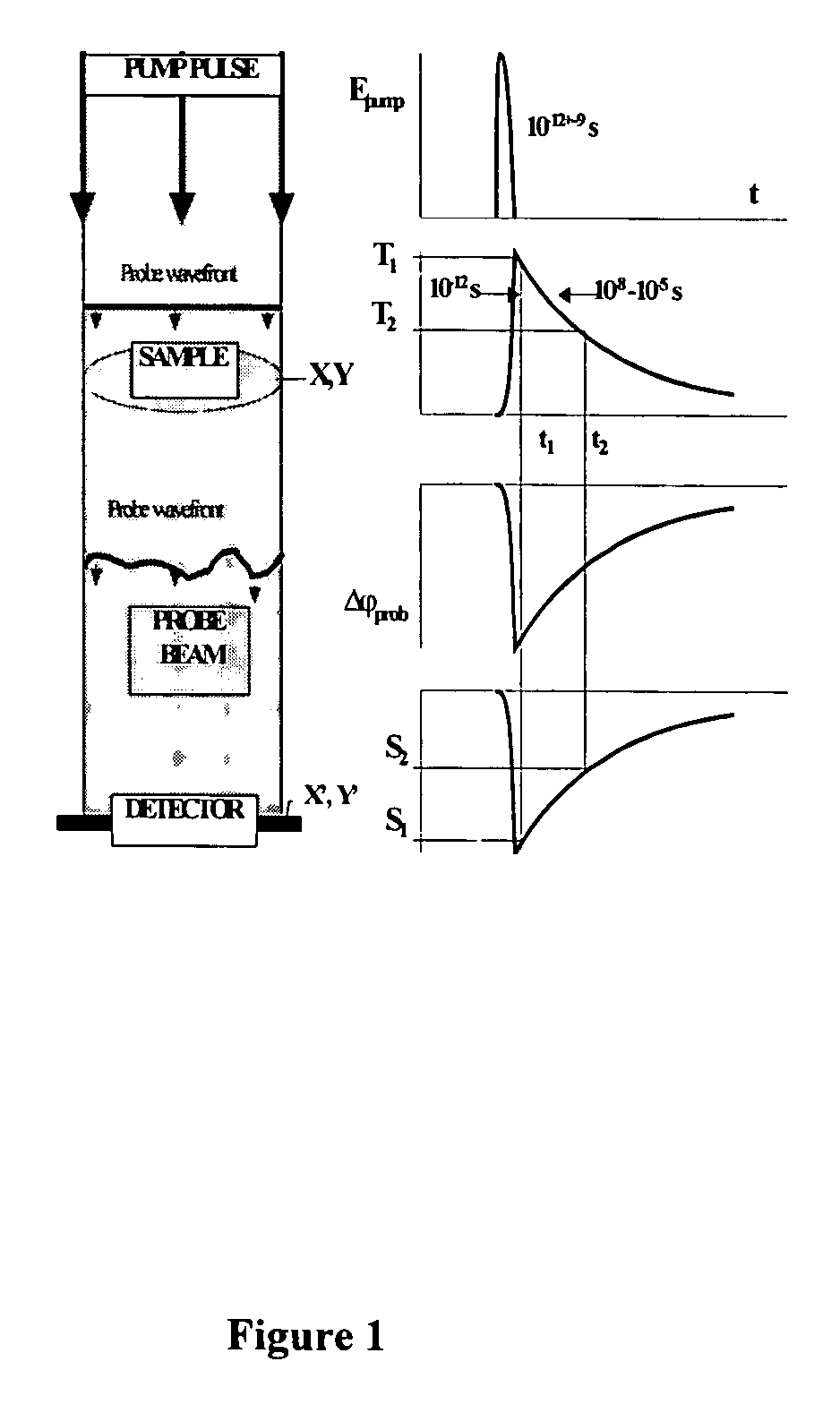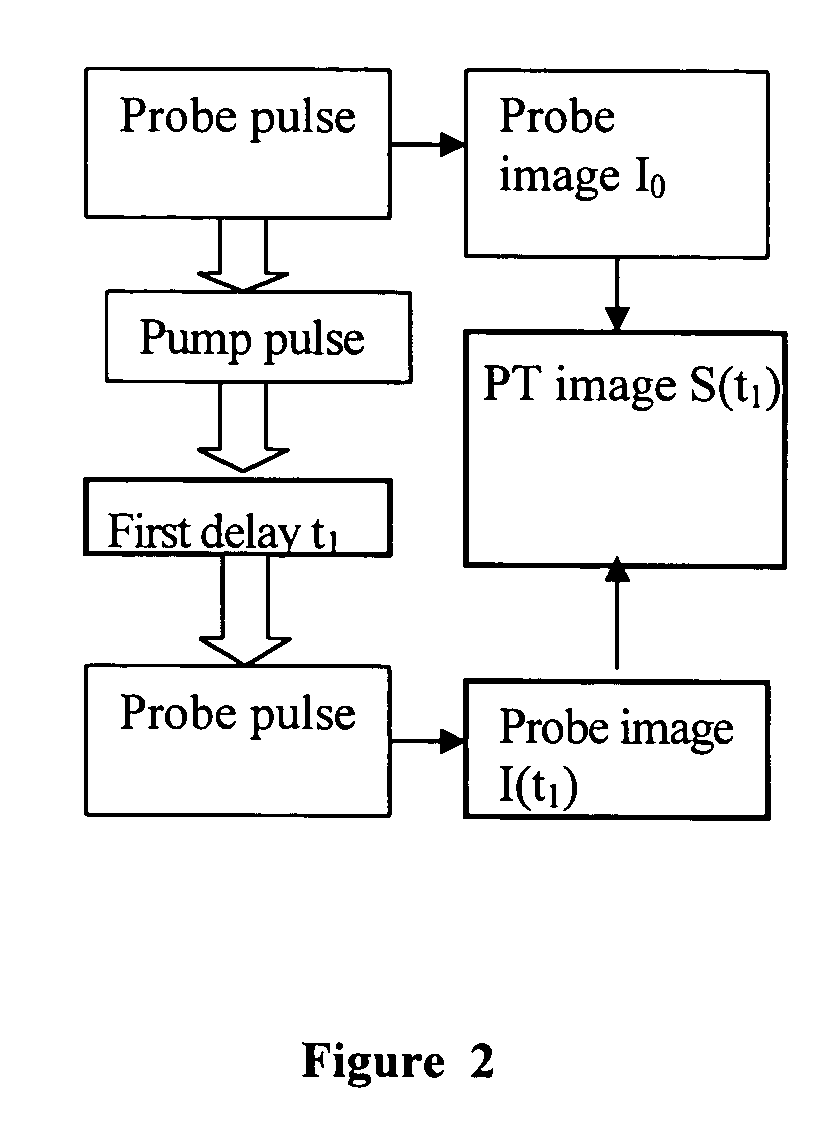Method and device for photothermal examination of microinhomogeneities
a photothermal and homogeneous technology, applied in the field of optical microscopy, can solve the problems of ineffective use of said methods and devices to examine optically transparent objects, low sensitivity of microscopes to analyze low absorption, and shortcoming of said method is laser beam scanning on the surface of observed objects, etc., to achieve spatial resolution, increase sensitivity, and informative value
- Summary
- Abstract
- Description
- Claims
- Application Information
AI Technical Summary
Benefits of technology
Problems solved by technology
Method used
Image
Examples
example 1
Study Microsamples in Diffraction Limited Image Mode
[0106]Technical basis for implementation of the device (shown in FIG. 5) is a standard optical microscope 15, equipped with unit 1 of the pump laser and unit 2 of the probe laser, photodetectors 7 and 8 and an apparatus-program device (not shown) to control the device components. The pulse pump laser of unit 1 allows irradiating the object in the visible diapason of the wavelengths ranging from 400 to 600 nm (parametrical solid state laser with the pump Nd: YAG). The pump beam is transformed to a one-mode beam using a forming unit 3 made as a spatial filter, and is focused on object 13 through an entry device 4 and a standard condenser of microscope 16. The pump irradiation is blocked by filter 17 after the object has been propagated. A probe laser 2 is a dye pulse laser having the duration of 6 ns and the wavelength of 630 nm and the energy regulated in the range of 1–100 nJ and focused (as an analogue to the pump beam) on the sta...
example 2
Implementation of a Laser Photothermal Microscope to Examine Biological Micro-Objects
[0120]2.1 Active diagnostics. When examining biological objects of a single cell type, the definition of active diagnostics in the method claimed is significantly widened and even partly altered. The reason is that it assumes not only examination of the value of thermal effects induced by radiation, but also examination of the cells' reaction to the dynamic (short-time) thermal excitement. It is important for many applications, and more particularly for the objects of laser medicine, laser safety and examination of the fundamental cell properties, examination of external effects including radiation, etc. The method for examination in this case is examining and comparing cells' reactions to various energies of the laser pump. Said reactions could be examined using both independent methods, e.g. biochemical and histological, and the pofotothermal method itself. The measurement scheme and the laser par...
example 3
The Mode for Photothermal Measurement of Submicron Microheterogeneities
[0135]One of the issues of intensively developing nanotechnologies in various scientific and technical fields is the lack of precise control of the technological processes forming new structures with the resolution capacity as large as a few run. The method claimed allows solving the problem using high resolution provided by the change of the nanostructures' cooling speed using the sources of laser radiation. An example for practical realization: the pump laser unit: a femtosecond pulse laser Cr:LiSAF, wavelengths, 850 nm in particular, energy range 1 μJ–3 mJ, pulse width 10−13 sec., the delay unit being realized as an optical delay line, a part of the pump beam being used as a probe beam. The expected resolution is 1–5 nm. Beside visualization of nanostructures, the device claimed also provides for the accomplishing of the control function and the impact function due to the strong interaction with sample because...
PUM
| Property | Measurement | Unit |
|---|---|---|
| sizes | aaaaa | aaaaa |
| wavelengths | aaaaa | aaaaa |
| diameter | aaaaa | aaaaa |
Abstract
Description
Claims
Application Information
 Login to View More
Login to View More - R&D
- Intellectual Property
- Life Sciences
- Materials
- Tech Scout
- Unparalleled Data Quality
- Higher Quality Content
- 60% Fewer Hallucinations
Browse by: Latest US Patents, China's latest patents, Technical Efficacy Thesaurus, Application Domain, Technology Topic, Popular Technical Reports.
© 2025 PatSnap. All rights reserved.Legal|Privacy policy|Modern Slavery Act Transparency Statement|Sitemap|About US| Contact US: help@patsnap.com



